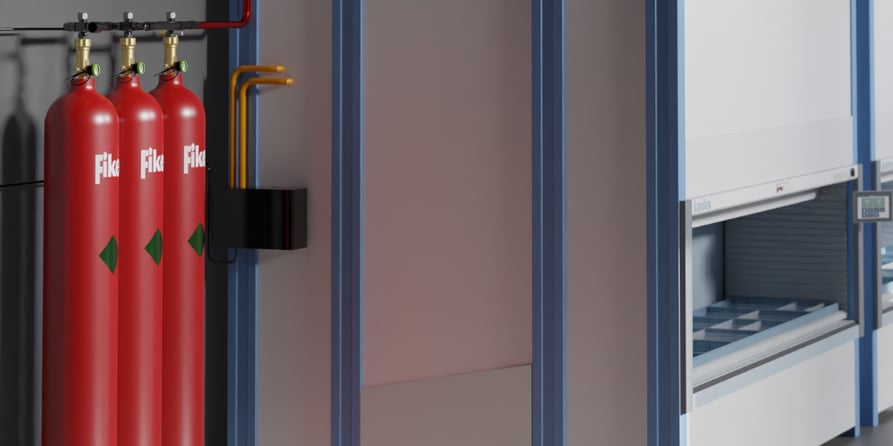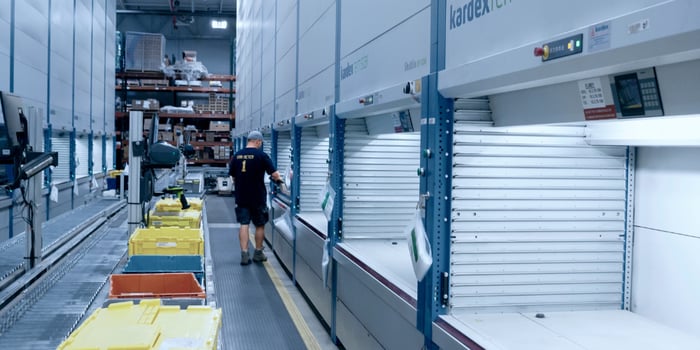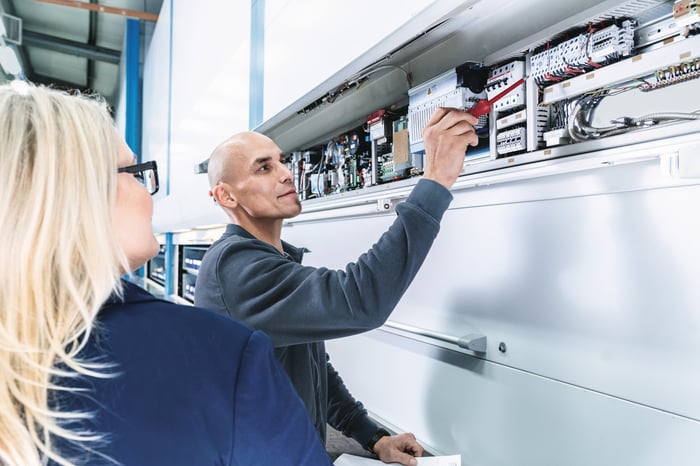It’s no secret that automated storage and retrieval systems (ASRS) are a real game-changer for warehousing. Storage systems like Vertical Lift Modules (VLMs) can optimize your warehouse storage space (saving up to 85% against traditional shelving), streamline your order picking, and secure your valuable or high-compliance inventory.
But with all their benefits, they aren’t entirely impervious to fire damage.
And if you’re using your VLM to store high-value, high-compliance, or highly-vulnerable inventory, this article is for you.
In this post, we partnered with the special hazard fire suppression experts at Fike. Fike has experience working directly with Kardex Remstar customers to create custom fire suppression solutions for their Vertical Lift Modules (VLMs). This article explores the unique fire safety challenges that traditional warehouse suppression systems may not be equipped to handle for your automated storage and retrieval systems.

Why You Should Consider Fire Safety for Your VLM
Vertical Lift Modules, and other types of automated vertical storage, present some interesting challenges when it comes to fire suppression and fire safety.
Vertical Lift Modules (VLMs) are designed to maximize storage by organizing materials within a compact, high-density tower that can extend 30 feet or more. While this design offers significant efficiency benefits, it also presents inherent fire risks. The enclosed structure limits airflow, which can allow heat and smoke to build up undetected. At the same time, the dense storage environment reduces the effectiveness of traditional fire protection methods such as passive smoke and heat detection and water-based sprinklers, making specialized fire suppression solutions essential.
For pharmaceuticals, medical devices, electronics, aerospace, and military equipment, the VLM is the perfect solution for high-security, high-density storage. However, fire poses a significant risk, in more ways than one. A fire – and just as importantly, water damage from a traditional sprinkler – can result in major product lost, down time, and compliance nightmares. Not to mention, a complete and total mess.
"As part of our continuous improvement initiatives, Fike expanded its facility by 4,500 square feet and installed two Kardex Vertical Lift Modules to manage more than $1 million in equipment and materials. This investment in Kardex technology replaced 12,500 square feet of traditional floor space, supporting overall company growth and efficiency. To safeguard these valuable assets, we implemented a clean agent suppression system paired with advanced air-sampling smoke detection, providing early warning and reliable fire protection. While expanding the existing water sprinkler system was an option, we chose to invest in inert gas clean agent suppression to ensure the highest level of protection for our critical inventory and infrastructure."
- Michael Lightfoot, Fike Executive Vice President, Operations
Why Traditional Fire Suppression Falls Short for VLMs
Sure, your standard sprinkler systems may meet code requirements. But they may not be the right fit for protecting your automated warehousing equipment. Especially ASRS like VLMs. In fact, relying solely on your traditional suppression can leave massive gaps in inventory protection.
1. The Risk of Water Damage is High
Sprinklers discharge massive amounts of water, which can damage electronics, packaging, and high value inventory – whether it’s stored in the VLM or outside of it. Sometimes, these systems even cause more damage than the fire itself.
2. Slower Response Times
Some sprinkler systems are designed to activate only after heat reaches a defined threshold. In enclosed storage environments, this delay in activation can allow a fire to grow unchecked, producing high levels of smoke, soot accumulation on surfaces, and pervasive odors. Beyond property damage, smoke can also introduce serious health risks, as it often contains toxic carcinogens and corrosive acids that pose both immediate and long-term hazards.
3. Limited Reach
Sprinkler heads are designed for open warehouse layouts where inventory is stored on traditional shelving units. Therefore, it’s important to consider how that may be limiting the protection of your enclosed vertical storage units.
We all know that any fire – large or small – can cause significant damage. Downtime. Product loss. And expensive recovery. That’s why it’s critical to consider an advanced, special hazard fire suppression solution for your automated shelving systems.
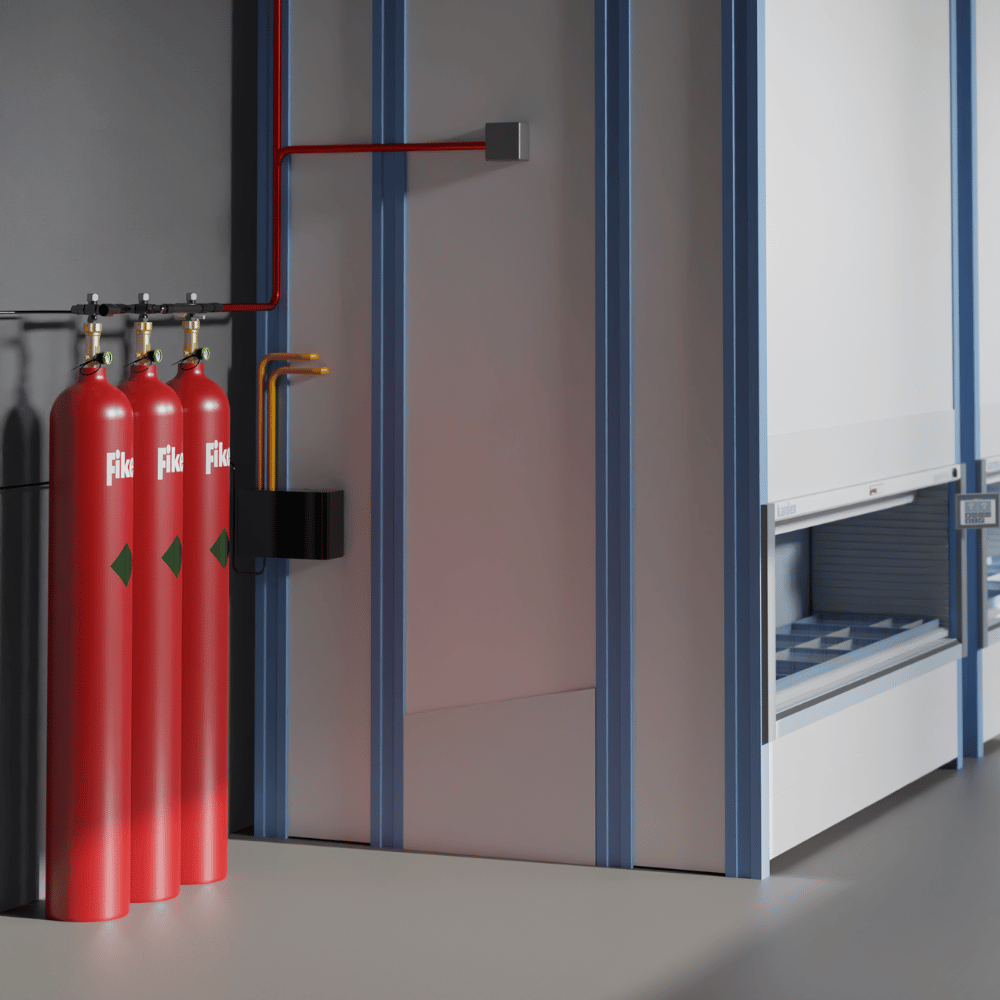
Warehouse Fire Suppression Designed for Vertical Lift Modules
The fire suppression solution created by Fike for Kardex Remstar isn’t just a collection of premium components. It’s the result of years of hands-on testing, refinement, and real-world learning. Every part of this system was intentionally selected and validated to deliver one thing: maximum protection with minimal disruption.
What makes this custom system so powerful?
The warehouse fire suppression system for ASRS combines four critical technologies, each playing a unique role in detecting, responding to, and extinguishing fires inside Kardex Shuttle VLMs.
 Learn more about how Kardex Remstar partners with Fike for advanced warehouse fire protection systems specifically designed for the Kardex Shuttle Vertical Lift Module.
Learn more about how Kardex Remstar partners with Fike for advanced warehouse fire protection systems specifically designed for the Kardex Shuttle Vertical Lift Module.
>> Get instant access to the brochure here.
Xtralis Air-Sampling Smoke Detection
Rather than waiting for smoke to become visible, Xtralis continuously samples the air inside the VLM, detecting incipient fire conditions early, long before traditional detectors would alarm. This early warning smoke detection can buy you valuable time and help ensure the system only activates when it’s truly needed.
Fike Cheetah Xi™ Control Panel
Fast, intelligent, and precise, you can think of Cheetah Xi as the system’s brain. It coordinates detection, alarm, and suppression with unmatched speed and accuracy. This smart control minimizes the risk of false discharges while delivering immediate response in true fire scenarios.
Fike Inert Gas Suppression (IG-100 – Nitrogen)
After rigorous testing of multiple clean agents, Fike identified IG-100 (100% nitrogen) as the ideal choice for ASRS environments. It’s fast-acting, residue-free, safe for occupied spaces, and won’t harm sensitive equipment.
Simply put, it’s the safest and most effective way to suppress fires in automated systems like VLMs.
Fike Horizon™ ASRS Nozzles
These nozzles are precision-engineered specifically for Kardex Remstar systems, optimized to deliver the clean agent throughout the VLM without interfering with any internal mechanics or operations. The design ensures the agent reaches where it’s needed.
This system didn’t come together overnight. Fike’s engineering and fire protection teams evaluated numerous configurations, tested multiple nozzle designs, explored alternative detection technologies, and validated discharge strategies in both simulated and real-world environments.
“Protecting ASRS machines demands more than standard fire protection. Backed by extensive testing and continuous improvement, Fike’s Horizon Nozzle and IG-100 Nitrogen clean agent fire suppression solution is proven as the best approach—delivering clean, reliable, and uncompromised protection.”
– Brad Stilwell, Fike Director, Special Projects
Warehouse Fire Suppression System Benefits by Industry Segment
We’ve already mentioned that automated storage systems, like VLMs, are ideal for a variety of industry segments. But each brings its own set of fire safety concerns.
"We understand the unique risks that come with automated storage systems like Kardex VLMs. This partnership was built to deliver a fire protection solution that meets those needs head-on."
- Michael Lightfoot, Fike Executive Vice President, Operations
Whether it’s compliance, contamination control, or seamless operations, here’s how Fike helps to provide targeted protection for your Kardex Remstar solution:
Warehouse Fire Suppression for Pharmaceuticals and Medical Device Manufacturing
When manufacturing pharmaceuticals or medical devices, cleanliness and compliance are everything. And we mean everything. Water or dry chemical-based fire suppression systems are notorious for compromising sterility, damaging packaging, and resulting in costly product damage.
Fike’s solution uses clean inert gas, which leaves no residue and does not affect the temperature or humidity of your controlled storage. With early smoke detection and precision-controlled suppression, this system helps you to stay compliant with regulatory standards and protect your products. (Not to mention your uptime…)
Warehouse Fire Suppression for E-Commerce and Retail
Speed and accuracy. That’s what your customers demand in the age of Amazon. A fire incident throws a massive wrench in your ever-tightening fulfillment windows. Not to mention, the safety of your staff and inventory. An integrated ASRS fire suppression system can detect and respond to fires with minimal disruption. It protects your inventory without triggering widespread shutdowns and cleanup.
Warehouse Fire Suppression for Electronics
Highly sensitive components are especially vulnerable to fire, water, and smoke, making sprinkler systems an absolute nightmare for this industry in particular. All it takes is a bit of water to ruin entire product batches from the moisture exposure alone. That’s why inert gas is such a powerful suppression solution for this industry. Protect your systems and your people from fire (and water) damage to reduce product loss risk and improve your business continuity.
Warehouse Fire Suppression for Manufacturing and Industrial Parts Storage
In the manufacturing sector, VLMs are ideal for storing your spare parts, tools, and maintenance inventory to support your production lines. A fire in just one unit could halt or delay operations for days. By integrating early detection with fast, clean suppression, you’ll be back up and running in no time.
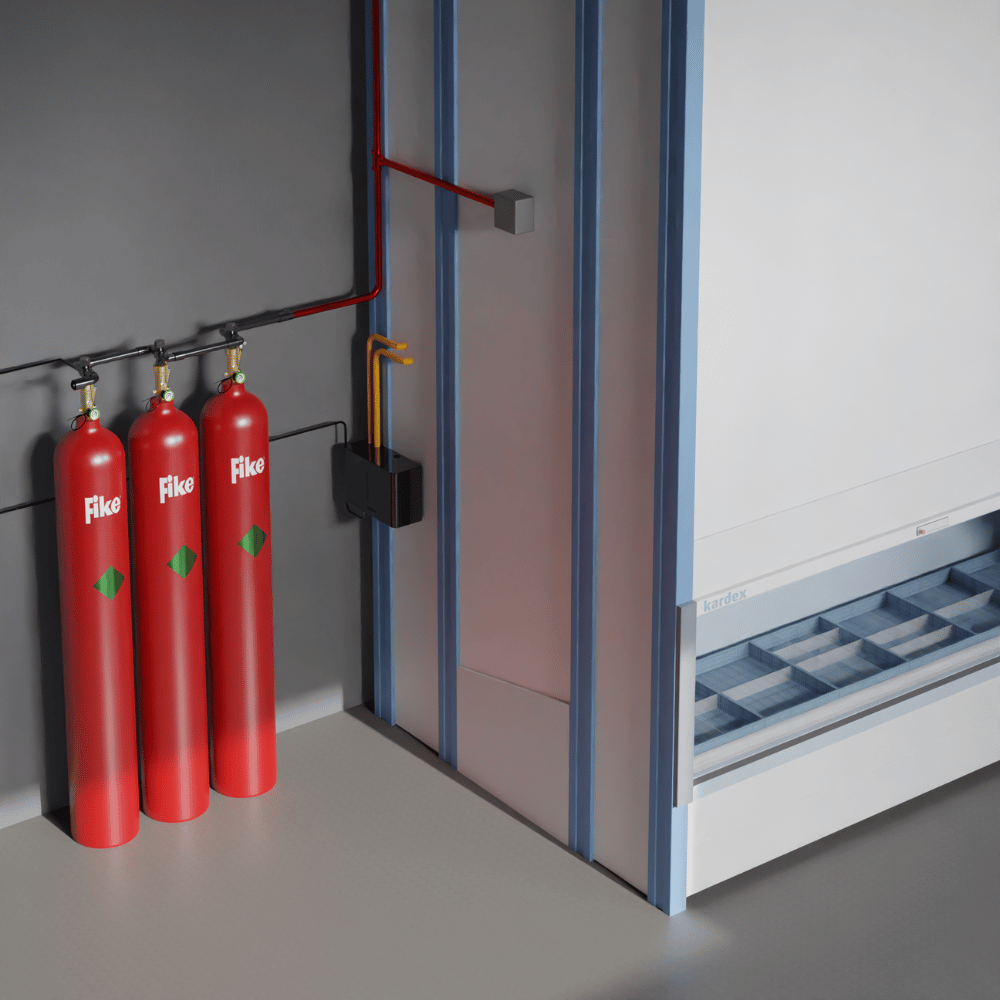
VLM Fire Safety Tips & Best Practices
Even the most advanced fire suppression system performs best when supported by a strong foundation of preventive practices. To ensure your Vertical Lift Modules (VLMs) are protected and compliant, here is what Fike recommends:
1. Conduct Regular Risk Assessments
Warehouses are dynamic environments. Equipment layouts change, inventory profiles evolve, and workflows shift. Each of these changes can affect your fire risk profile. Regular risk assessments can help you to identify new vulnerabilities and ensure that your fire suppression system remains properly aligned with your operational reality.
2. Keep VLMs Clean and Clutter-Free
Like any equipment on your production line, dust buildup and stray debris near motors, sensors, or control panels can increase fire risk and impair system performance.
That’s why routine cleaning and maintenance around and inside the VLM can ensure that the components operate efficiently while reducing the chances of an ignition source going unnoticed.
3. Store Flammable Materials Responsibly
Volatile or combustible materials should never be stored in a VLM (unless the system has been specifically designed to handle such items).
If your storage requirements change after installation, consult with Fike to review the fire protection system’s design.
This step is essential to confirm that suppression capabilities remain appropriate and effective for the revised inventory.
4. Integrate Early Smoke Detection Technology
Traditional smoke detectors may not activate early enough in enclosed systems like VLMs. Aspirating smoke detection systems, such as VESDA, continuously sample the air for incipient fire conditions, often identifying combustion before smoke is even visible.
This early detection provides crucial time to respond or suppress the fire before it escalates.
5. Train Staff on Emergency Response Procedures
Your people are the first line of defense in any emergency.
Ensure that your team members are trained in fire extinguisher use, emergency stops, evacuation procedures, and procedures when the fire suppression system activates.
Clear roles and routine drills increase confidence and speed in high-stress scenarios.
6. Partner with Integrated Solution Providers
When fire protection is treated as an afterthought (or handled by disconnected vendors), gaps in compatibility or response are common. That’s why you should consider working with an integrated solution partner like Fike, which can work with you to ensure your fire suppression system is purpose-built for the storage equipment in use.
7. Follow NFPA Guidelines for System Inspection and Maintenance
Periodic inspections and functional testing are essential to maintaining system readiness. In accordance with NFPA requirements, your fire suppression system should undergo routine evaluation and maintenance. Staying compliant not only protects your equipment and personnel but also ensures insurance and regulatory standards are met.
 Learn more about how Kardex Remstar partners with Fike for advanced warehouse fire protection systems specifically designed for the Kardex Shuttle Vertical Lift Module.
Learn more about how Kardex Remstar partners with Fike for advanced warehouse fire protection systems specifically designed for the Kardex Shuttle Vertical Lift Module.
>> Get instant access to the brochure here.
Have an existing Kardex Shuttle VLM? Work with our team to retrofit your Shuttle today!

